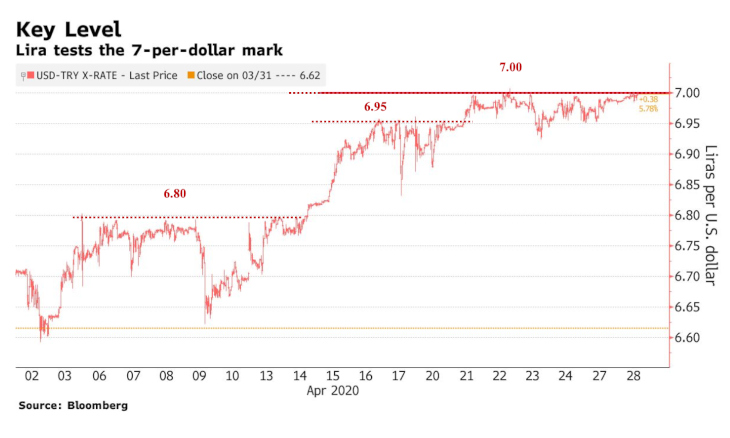Fear of floating in Ankara
In those countries where it is presented as they have a “floating exchange rate regime,” if their central banks are intervening at the exchange rate, the name of this in economy literature is “fear of floating.”
There is no sea at Turkey’s capital city Ankara but there is scary amount of “fear of floating.” This fear is typical of those who have lost their credibility. Let us go back to the beginning of the story before we come to this.
Central Bank Governor Murat Uysal announced the second annual Inflation Report on April 30. The inflation foreseen for the end of 2020 in the report was reduced 0.8 percent to 7.4 percent compared to the forecast in January. What made this change were the downward update of 1.2 points in output gap and 0.3 points in food prices as well as the 0.5 points change in labor costs and the 0.2 points coming from exchange rate increase.
There are detailed analyses in the bank’s report; a significant amount of uncertainty emphasis accompanies these analyses. Especially the “output gap” is worth looking at. It can be understood that the bank is expecting a significant downsizing in economy in the quarter we are in.
Nobody has any in depth forecast on how the pandemic will unfold and what damages it will cause in economy. Analyses based on basic assumptions are shared within a great extent of uncertainties.
The Central Bank is nowhere far from this. It shared a moderate angle “without scaring anyone, with the middle of the road approach.”
One other factor leading the uncertainties in the report was what kind of a balance would be created between the losses in exports and tourism, and the positive effect brought by the fall in imports and the prices of commodities and energy.
I asked this question to Governor Uysal in a press conference held through the program named “Zoom.” Uysal left it pretty vague saying they were expecting a “moderate course in the balance of payments.” Also, in the report, it is forecast that “the loss in tourism revenues will have important reflections on growth, employment and current accounts balance.” However, despite the expected slowdown in goods and services exports, with the restrictive effect of commodity prices and imports, it is forecast, in the report, that “the balance in current accounts will have a moderate course throughout the year in general.”
If tourism revenues in last year’s April-December period are taken into consideration, the loss alone in tourism in the remaining three quarters of the year will probably be at around of 25 billion dollars. If with a quite optimistic approach, there is an assumption as “the epidemic will fade toward the end of June; a gradual recovery and tourist flow will start;” if the “moderate course” is based on this, then it is not at all realistic.
The losses in exports are also similar. In the report, there is the assessment of, “the 1 point rise in foreign market growth has increased the growth in exports – except gold - 3 points.” After it was pointed out, “The shrinkage foreseen because of the pandemic in our foreign markets led European countries will seriously restrict our export facilities in 2020.” After saying this, how this leads to tourism and other developments to “moderate current accounts balance,” we cannot understand.
It is also a wonder what kind of an economic benefit it would bring to defend the foreign exchange rate while the problems seen at the horizon in the balance of payments are “swept under the carpet.”
Hallucinating?
A journalist asked Governor Uysal, “Why are you selling foreign currency from the public bank channels? Have we switched to the public controlled exchange rate system from the floating exchange rate regime?” As a follow up to this question, I asked, “There is a covert defense of the exchange rate level which is becoming more and more visible. The dollar exchange rate should not pass 7.00, but it can stay at 6.9950. What kind of an economic rationale is this?”
Uysal’s answer to both of these questions was this, in “average.”
“We can see that this not the case very clearly. Even though it has speeded up since the second half of March, we have seen a gradual change in the foreign exchange rate, a certain amount of depreciation in the Turkish Lira. We are not alone in this field; also, in other developing countries there are those with a higher rate, there are those with a lower rate. Depreciation in the Turkish Lira is somewhere in the middle, somewhere a little below the average. This actually shows that we do not have a style of defending the level at foreign exchange rate. We should also be protecting the real exchange rate level. With the latest development, the real exchange rate level is at its lowest in the past periods.”
Uysal also emphasized that they need to watch the “stability in foreign exchange rate.”
Let me remind this again especially. My question was about “defending the level of exchange rate.” It was “the secret of the town” which everybody knew and everybody saw. Governor Uysal preferred to answer it like the ongoing rate defense that public banks worked on 7 days 24 hours to protect certain levels was “not happening, it never existed.”
Here is Bloomberg’s daily course of the dollar exchange rate graphics.

From this chart, we can see that during the month of April, in the first 15 days, foreign currency was sold “defending the rate” to keep the level below 6.80; when a huge exit occurred, the rate was let free for some time, then this was continued again.
On the third week of April, it is known and it can be seen that the defending of the exchange rate set the ceiling limit at 6.95 and it was continued as such; then as a result of a new wave arriving, it was at the 7 limit.
I don’t know how it could be explained that by looking in the eyes of economic units, experts and economists one can say this is not being done, while the drop of reserves of the Central Bank during the same period tells us many things as the proof of this.
While Central Bank Governor Uysal was saying there were fluctuations happening in exchange rates as well as reserves, and that this was happening in all developing countries, he was emphasizing there was no change in the foreign exchange rate system and that the floating exchange rate regime was continuing. He added, “However, in such times, in order to protect financial stability, there are changes happening in our foreign exchange reserves in different channels.”
In those countries where it is presented as they have a “floating exchange rate regime,” if their central banks are intervening at the exchange rate, the name of this in economy literature is “fear of floating.”
In an article written in 2002 by economists Guillermo Calvo and Carmen Reinhart, the reasons for the fear of floating was stated as high dollarization due to the lack of credibility, higher passthrough from exchange rate and the concern for a sudden stop.
These reasons cause the floating exchange rate regime to be interrupted. The money authority is uneasy about the free practice of the exchange rate regime; in other words, it has fear of floating. Direct or indirect interventions are done to the foreign currency market. Even if the exchange rate reaches a stability, it causes fluctuations in reserves.
Lack of credibility destroys the authority of the central bank. Expectations determine the direction. They nourish dollarization. They restrict the central banks from acting as an effective authority. The fear of floating dominates. How? It does sound familiar regarding the last couple of years, right?
Our Central Bank that has handed over the control of monetary policy in Ankara to the Presidential Palace Complex at Beştepe is exactly in this position. So much so that it is not only an intervention against fluctuation, but it has transformed into a meaningless “exchange rate defense,” probably determined by minds unknown to us.
Making a level defense like an “aggressive trader” through public banks channel erodes the reserves of the Central Bank. Most probably, it looks as though this course of events will qualify as a new chapter in economy literature.
Impossibility of the impossible
The Mundell-Fleming model, better known as the concept of “impossible trinity,” tells us that when capital movements are free, both the exchange rate and the interest rate cannot be controlled simultaneously.
The floating exchange rate regime, because of its flexibility that absorbs shocks, enables monetary policy to function independently. For instance, when the foreign currency buyer enters the market, the exchange rate increases. The increased rate both becomes expensive for new buyers and also depending on the situation, becomes attractive for potential sellers.
When capital accounts are free, it is impossible to say “let me keep the interest rate low and at the same time the exchange rate should not exceed a certain level.”
Except for intervening at extreme situations, defending an exchange rate level -determined in the minds of some people - means the regulated sale of cheap foreign currency for capital exit. Also, since foreign currency reserves are not endless, it means rapid erosion of reserves.
This is the picture that has ever become evident in the past two months.
Now, while Ankara, in this “experiment,” is rapidly eroding reserves, it is locking the capital account freedom, fast approaching closure.

